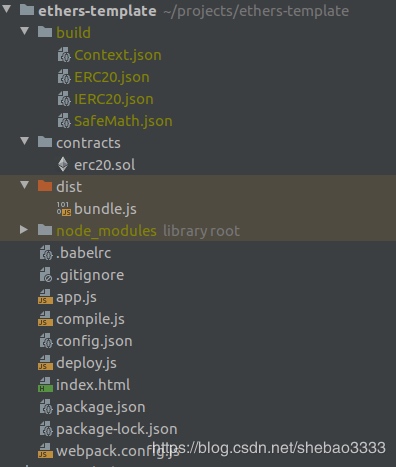用Ethers.js构建一个简单的DApp
- 虎丘之巅
- 发布于 2020-01-08 15:23
- 阅读 1760
如果你已经在以太坊上开发过DApp,那你在前端JavaScript中可能用过 web3.js。Ethers.js可算是一个轻量级的web3.js,本文将介绍如何使用Ether.js构建一个简单的DApp。
与Web3.js相比,Ethers.js有很多优点,如Ethers.js提供的状态和密钥管理就非常的好用。
Web3的设计场景是DApp应该连接到一个本地节点, 由这个节点负责保存密钥、签名交易并与以太坊区块链交互。现实并不是这样的,绝大多数用户不会在本地运行一个geth节点。Metamask在浏览器应用中有效地模拟了这种节点环境,因此绝大多数web3应用需要使用Metamask 来保存密钥、签名交易并完成与以太坊的交互。
Ethers.js采取了不同的设计思路,它提供给开发者更大的灵活性。Ethers.js 将“节点”拆分为两个不同的角色:
- 钱包:负责密钥保存和交易签名
- 提供器:负责以太坊网络的匿名连接、状态检查和交易发送
编译、部署智能合约
本文中我们要与一个ERC20智能合约交互,需要在机器里先安装 nodejs和npm。
创建项目文件夹
首先创建一个文件夹ethers-template,然后在这个文件夹里再创建另一个 contracts文件夹:
~$ mkdir -p ethers-template/contracts初始化npm配置
然后进入ethers-template目录初始化npm配置:
~$ cd ethers-template
~/ethers-template$ npm init -y创建项目配置文件
接下来创建一个config.json文件保存你的项目配置:
{
"private_key": "24C4FE6063E62710EAD956611B71825B778B041B18ED53118CE5DA5F02E494BA",
"network": "kovan",
"ERC20": "0x0DEd9F7D82a24099F09AF7831CaB61B31Df10487",
"name": "Kanchan Coin",
"symbol": "SNK",
"total_supply": "1000000000000000000000000",
"decimals": 18
}说明如下:
- private_key:账户私钥,将使用这个私钥对应的账户在指定网络上部署智能合约。
- network:要接入的以太坊网络,ethers.js支持以下网络:
- homestead:主网
- rinkeby
- ropsten
- kovan
- goerli
- ERC20:声明要交互的已部署合约,可选
- name/symbol/decimals:ERC20合约的参数
安装ethers.js
现在可以安装ethers.js了:
~/ethers-template$ npm install --save ethers安装编译合约需要的npm包
为了编译合约,我们还需要安装solc和fs-extra:
~/ethers-template$ npm install fs-extra@8.1.0 solc@0.5.11 --save创建ERC20合约代码
在contracts目录下创建文件erc20.sol:
~/ethers-template$ touch contracts/erc20.sol并按如下修改:
pragma solidity ^0.5.0;
contract ERC20 {
using SafeMath for uint256;
event Approval(address indexed tokenOwner, address indexed spender, uint tokens);
event Transfer(address indexed from, address indexed to, uint tokens);
mapping(address => uint256) balances;
mapping(address => mapping (address => uint256)) allowed;
string public symbol;
uint8 public decimals;
string public name;
uint256 private _totalSupply;
constructor(uint8 _decimals, string memory _symbol, string memory _name, uint256 _total_supply) public{
decimals = _decimals;
symbol = _symbol;
name = _name;
_totalSupply = _total_supply;
balances[msg.sender] = _totalSupply;
}
function totalSupply() public view returns (uint256) {
return _totalSupply;
}
function balanceOf(address tokenOwner) public view returns (uint) {
return balances[tokenOwner];
}
function transfer(address receiver, uint numTokens) public returns (bool) {
require(numTokens <= balances[msg.sender]);
balances[msg.sender] = balances[msg.sender].sub(numTokens);
balances[receiver] = balances[receiver].add(numTokens);
emit Transfer(msg.sender, receiver, numTokens);
return true;
}
function approve(address delegate, uint numTokens) public returns (bool) {
allowed[msg.sender][delegate] = numTokens;
emit Approval(msg.sender, delegate, numTokens);
return true;
}
function allowance(address owner, address delegate) public view returns (uint) {
return allowed[owner][delegate];
}
function transferFrom(address owner, address buyer, uint numTokens) public returns (bool) {
require(numTokens <= balances[owner]);
require(numTokens <= allowed[owner][msg.sender]);
balances[owner] = balances[owner].sub(numTokens);
allowed[owner][msg.sender] = allowed[owner][msg.sender].sub(numTokens);
balances[buyer] = balances[buyer].add(numTokens);
emit Transfer(owner, buyer, numTokens);
return true;
}
}
library SafeMath {
function sub(uint256 a, uint256 b) internal pure returns (uint256) {
assert(b <= a);
return a - b;
}
function add(uint256 a, uint256 b) internal pure returns (uint256) {
uint256 c = a + b;
assert(c >= a);
return c;
}
}编写合约编译脚本
下面的代码使用solc编译合约文件,将其保存为compile.js:
const path = require('path');
const fs = require('fs-extra');
const solc = require('solc');
const config = require('./config.json');
const sourceFolderPath = path.resolve(__dirname, 'contracts');
const buildFolderPath = path.resolve(__dirname, 'build');
const getContractSource = contractFileName => {
const contractPath = path.resolve(__dirname, 'contracts', contractFileName);
const source = fs.readFileSync(contractPath, 'utf8');
return source;
};
let sources = {};
fs.readdirSync(sourceFolderPath).forEach(contractFileName => {
sources = {
...sources,
[contractFileName]: {
content: getContractSource(contractFileName)
}
}
});
const input = {
language: 'Solidity',
sources,
settings: {
outputSelection: {
'*': {
'*': [ '*' ]
}
}
}
}
console.log('\nCompiling contracts...');
const output = JSON.parse(solc.compile(JSON.stringify(input)));
console.log('Done');
let shouldBuild = true;
if (output.errors) {
console.error(output.errors);
// throw '\nError in compilation please check the contract\n';
for(error of output.errors) {
if(error.severity === 'error') {
shouldBuild = false;
throw 'Error found';
break;
}
}
}
if(shouldBuild) {
console.log('\nBuilding please wait...');
fs.removeSync(buildFolderPath);
fs.ensureDirSync(buildFolderPath);
for (let contractFile in output.contracts) {
for(let key in output.contracts[contractFile]) {
fs.outputJsonSync(
path.resolve(buildFolderPath, `${key}.json`),
{
abi: output.contracts[contractFile][key]["abi"],
bytecode: output.contracts[contractFile][key]["evm"]["bytecode"]["object"]
},
{
spaces:2,
EOL: "\n"
}
);
}
}
console.log('Build finished successfully!\n');
} else {
console.log('\nBuild failed\n');
}上面的代码将读入并编译contracts目录中的所有合约文件, 然后将编译得到的abi和字节码保存为json文件。
编译合约
现在使用compile.js来编译erc20.sol合约:
~/ethers-template$ node compile.js编译结束后,我们得到如下的目录结构;
+ethers-template
+compile.js
+contracts
-erc20.sol
+build
-ERC.json
-Context.json
-IERC20.sjon
-SafeMath.json
-package.json编写合约部署脚本
创建文件deploy.js:
~/ethers-template$ touch deploy.js然后按如下修改:
const startTimestamp = Date.now();
const ethers = require('ethers');
const config = require('./config.json');
const fs = require('fs-extra');
const provider = ethers.getDefaultProvider(config["network"]);
const wallet = new ethers.Wallet(config["private_key"], provider);
console.log(`Loaded wallet ${wallet.address}`);
let compiled = require(`./build/${process.argv[2]}.json`);
(async() => {
console.log(`\nDeploying ${process.argv[2]} in ${config["network"]}...`);
let contract = new ethers.ContractFactory(
compiled.abi,
compiled.bytecode,
wallet
);
let instance = await contract.deploy(config["decimals"], config["symbol"], config["name"], config["total_supply"]);
console.log(`deployed at ${instance.address}`)
config[`${process.argv[2]}`] = instance.address
console.log("Waiting for the contract to get mined...")
await instance.deployed()
console.log("Contract deployed")
fs.outputJsonSync(
'config.json',
config,
{
spaces:2,
EOL: "\n"
}
);
})();注意:
- 上面代码中的默认网络是kovan测试网
- 在这个测试网中,你的账号需要一些以太币来支付部署交易的手续费
- 将使用config.json中的private_key来部署合约
部署合约
运行deploy.js脚本时,需要在命令行传入要部署的合约名称ERC20:
~/ethers-template$ node deploy.js ERC20输出结果:
Loaded wallet 0xC8e1F3B9a0CdFceF9fFd2343B943989A22517b26
Deploying ERC20 in kovan...
deployed at 0x77Bb3546f5ee356E4026BaA96b7DDf22141bd77B
Waiting for the contract to get mined...
Contract deployed在与合约交互时需要合约部署地址,上面的代码会自动将合约部署 地址保存到config.json文件中。
与智能合约交互
在本文中,我们使用ES6来编写合约交互代码,然后使用webpack 和babel将ES6代码转换为ES5代码。
安装ES6构建工具
首先安装这些依赖项:
~/ethers-template$ npm i webpack webpack-cli @babel/core \
@babel/plugin-proposal-object-rest-spread \
@babel/preset-env babel-loader \
babel-polyfill -D
编写前端脚本
创建一个文件app.js:
~/ethers-template$ touch app.js然后按照如下修改:
const ethers = require('ethers');
const config = require('./config.json');
// Import the json file from build to get the abi
const erc_json = require('./build/ERC20.json'); //import the json of the contract which you want to interact
// You can use any standard network name
// - "homestead"
// - "rinkeby"
// - "ropsten"
// - "kovan"
// - "goerli"
const provider = ethers.getDefaultProvider(config['network']);
// Make a wallet instance using private key and provider
const wallet = new ethers.Wallet(config['private_key'] , provider);
const address = config["ERC20"];
const abi = erc_json.abi;
erc20 = new ethers.Contract( address , abi , wallet );
document.getElementById("send").onsubmit = async function(e) {
e.preventDefault();
let address = document.getElementById("address").value;
document.getElementById("status").innerText = "Waiting for transaction to get published...";
let tx = await erc20.functions.transfer(address, "1000000000000000000");
let tx_hash = tx.hash;
let node = document.createElement("LI");
let link = document.createElement("A");
link.target = "_blank";
link.href = `https://${config["network"]}.etherscan.io/tx/` + tx_hash;
let textnode = document.createTextNode(tx_hash);
link.appendChild(textnode);
node.appendChild(link);
document.getElementById("transactions").appendChild(node);
document.getElementById("status").innerText = "Waiting for transaction to be mined...";
await tx.wait();
document.getElementById("status").innerText = "Transaction confirmed";
return false;
};首先需要指定要使用的网络/提供器:
const provider = ethers.getDefaultProvider(config['network']);为了与合约交互,需要2个东西:
- 合约部署地址
- 合约ABI接口
在上面app.js中,我们从配置文件引入了合约地址,从合约编译结果目录中 引入了合约ABI:
//import the json of the contract which you want to interact
const erc_json = require('./build/ERC20.json');
const config = require('./config.json');
const address = config["ERC20"];
const abi = erc_json.abi;创建钱包实例
为了创建合约实例,我们需要先创建一个钱包实例,这样不管什么时候调用 setter方法,都需要一个私钥来签名交易。在ethers.js中,你只需要 创建钱包,所有的setter方法就会由这个钱包签名。
const wallet = new ethers.Wallet(config['private_key'] , provider);你也可以使用keystore和助记词来创建一个钱包。如果你希望用这个钱包与 智能合约交互,你还需要传入提供器。如果你只是想用私钥签名消息,那么 就不需要提供器了。
erc20 = new ethers.Contract( address , abi , wallet );上面的代码创建了一个合约实例,然后你就可以像这样调用合约函数:
erc20.functions.function_name_in_smart_contract(parameters);备注:在ERC20中定义了一个函数transfer,它的参数是转账地址和代币数量。 下面的代码调用了合约的transfer函数,钱包将签名这个交易,然后发布到指定 的网络中:
erc20.functions.transfer(address, "1000000000000000000");
注意:无论任何时候你要创建一个交易,钱包里都需要以太币来支付交易手续费。
修改启动脚本
在package.json中添加:
"deploy": "node compile.js && node deploy.js ERC20",
"build": "webpack — mode production',修改后的package.json如下:
{
"name": "ethers-template",
"version": "1.0.0",
"description": "",
"main": "webpack.config.js",
"scripts": {
"deploy": "node compile.js && node deploy.js ERC20",
"build": "webpack --mode production",
"test": "echo \"Error: no test specified\" && exit 1"
},
"keywords": [],
"author": "",
"license": "ISC",
"dependencies": {
"ethers": "^4.0.37",
"fs-extra": "^8.1.0",
"solc": "^0.5.11"
},
"devDependencies": {
"@babel/core": "^7.6.0",
"@babel/plugin-proposal-object-rest-spread": "^7.5.5",
"@babel/preset-env": "^7.6.0",
"babel-loader": "^8.0.6",
"babel-polyfill": "^6.26.0",
"webpack": "^4.40.2",
"webpack-cli": "^3.3.9",
"webpack-dev-server": "^3.8.1"
}
}如果你后续修改了智能合约,就需要重新编译和部署。可以用一个命令来完成合约的编译和部署:
~/ethers-template$ npm run deploy这个命令会自动修改配置文件和合约构件文件。这样在与合约交互时,你就不需要修改合约地址或者ABI接口了。
如果你修改了app.js,也需要重新构建前端代码:
~/ethers-template$ npm run build这会生成新的发布版本:dist/bundle.js。
创建宿主html文件
创建一个新的文件index.html:
~/ethers-template$ touch index.html按如下修改:
<!doctype html>
<html lang="en">
<head>
<meta charset="utf-8"/>
<title>Ethers Template</title>
<style>
body {
padding-top: 75px;
}
.search-container {
width: 490px;
display: block;
margin: 0 auto;
}
input#address {
margin: 0 auto;
width: 100%;
height: 45px;
padding: 0 20px;
font-size: 1rem;
border: 1px solid #D0CFCE;
outline: none;
}
.center {
text-align: center;
}
ol {
counter-reset: list;
list-style: none;
}
li {
counter-increment: list;
margin-bottom: 10px;
}
li::before {
content: counter(list, decimal-leading-zero);
background: #2b4353;
font-family: Arial, sans-serif;
color: #fff;
font-size: 13px;
text-align: center;
border-radius: 50%;
width: 2.2em;
height: 2.2em;
line-height: 2.3em;
display: inline-block;
margin-right: 1em;
}
.button {
background-color: #4CAF50;
border: none;
color: white;
padding: 15px 32px;
text-align: center;
text-decoration: none;
display: inline-block;
font-size: 16px;
margin: 19px;
cursor: pointer;
}
</style>
</head>
<body>
<div class="center">
<h1>Ethers Template</h1>
<form class="search-container" id="send">
<input type="text" id="address" placeholder="Enter you address to get kanchan Coin">
<button type="submit" class="button">Send</button>
</form>
<h2>Status:</h2>
<p id="status"></p>
<h2>Transactions</h2>
<ol id="transactions">
</ol>
</div>
<script src="dist/bundle.js"></script>
</body>
</html>现在你的文件夹看起来就是这样了:

其中build文件夹将在运行compile.js之后自动创建,而dist 文件夹是在npm run build执行后自动创建。
用浏览器访问看起来是这样:

原文链接:Compiling, Deploying and Interacting with Smart Contract using JavaScript
- cesssss 71 浏览
- 社区API接口文档 131 浏览
- 文章文章2 48 浏览
- 安全的处理 ERC20 转账(解决非标准 ERC20 问题) 388 浏览
- Nervos x Gitcoin bounty 任务5:给已经存到 Layer2 的 sUDT部署一个 ERC20 的代理合约 254 浏览
- 以太坊私链部署erc20_usdt代币 419 浏览
- 如何在 DFINITY 上铸造自己的 Token?关于 Token 标准的讨论 467 浏览
- Hardhat中使用ethers.js和Waffle进行测试 260 浏览
- 以太坊全栈开发完全指南 4507 浏览
- web3.js 使用教程第二篇(version:1.3.5)- 合约交互,发送ETH,发送ERC20代币 2266 浏览
- 以太坊 JavaScript 库:web3.js 与 ethers.js 比较(第一部分) 1393 浏览
- 在以太坊上部署智能合约和管理交易 1392 浏览
